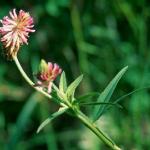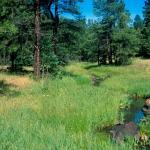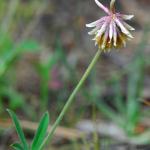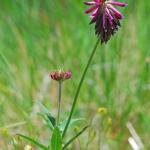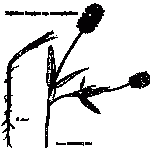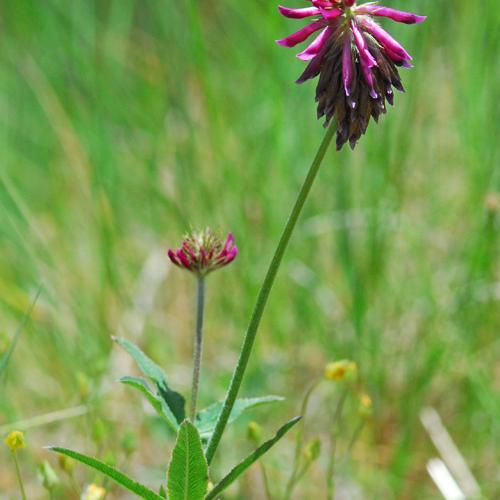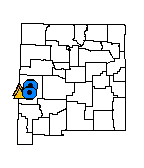Trifolium longipes var. neurophyllum (Mogollon Clover)
TRIFOLIUM NEUROPHYLLUM GREENE,
TRIFOLIUM LONGIPES NUTTALL SSP. NEUROPHYLLUM (GREENE) GILLET
| USFWS | State of NM | USFS | BLM | Navajo Nation | State Rank | Global Rank | R-E-D Code | NMRPTC Status | Strategy Status |
|---|---|---|---|---|---|---|---|---|---|
| SEN | S2 | G2 | 1-2-2 | R | SS |
| Overall Conservation Status | Documented Threats | Actions Needed |
|---|---|---|
| WEAKLY CONSERVED | water management/use |
Status surveys on abundance, distribution and threats. Study effects of forest fires and livestock grazing |
Perennial erect or decumbent herb; 14-60(-80) cm tall; leaves compound, trifoliate; leaflets 10-35 mm long, narrowly lanceolate, acuminate, margins toothed; peduncles pubescent, bractless, terminated by globose flower heads 20-30 mm long; flowers reflexed in age; calyx 7-10 mm long, teeth at least twice as long as the tube, distinctively white-villous; corolla 10-20 mm long, purple, purple-white, pink, or white; pods with 1-2(6) seeds. Flowers late July to September.
Trifolim longipes ssp. pygmaeum has a pilose calyx and smaller (10-15 mm) flower heads. Trifolim longipes ssp. reflexum does not have the white-villous calyx of ssp. neurophyllum.
New Mexico, Catron County; adjacent Arizona.
Wet meadows, springs and along riparian corridors in montane coniferous forest; 1,950-2,750 m (6,500-9,000 ft).
There are approximately 19 known sites with ssp. neurophyllum in Arizona and 20 in New Mexico. Grazing pressures modify the growth habit. Plants in intensely grazed areas are prostrate rather than erect, and have very few flowering stems. Anecdotal observations have been made that elk and livestock eat the purple flower heads preferentially over the pale-colored ones. Whether a perceived change in proportions of the different flower colors is related to grazing/browsing pressure can only be speculated. It is clear that the preferred habitat is wet meadows/beside streams. However, several plants in Arizona have been found in relatively dry conditions under ponderosa pine canopy.
This species grows best in damp meadows or beside streams and seeps. At least one relatively large population located more than 10 years ago in a damp canyon bottom in New Mexico has been extirpated. It is notable that this canyon is no longer damp. Therefore, it is reasonable to assume that disturbance of riparian/wetland areas will be deleterious to this species' survival. Current information cannot predict whether there will be a direct effect from livestock grazing/elk browsing on the long-term sustainability of the species. It is anticipated that the exclosures erected around selected populations in Arizona will alleviate the effects of intense grazing pressure. The effects of forest fire on this species have not been studied.
*New Mexico Native Plants Protection Advisory Committee. 1984. A handbook of rare and endemic plants of New Mexico. University of New Mexico Press, Albuquerque.
Greene, E.L. 1905. Trifolium neurophyllum. Leaflets of Botanical Observation and Criticism 1:154.
Gillett, J.M. 1969. Taxonomy of Trifolium (Leguminosae) II. The longipes complex in North America. Canadian Journal of Botany 47:93-113.
Isely, D. 1980. New combinations and one new variety in Trifolium (Leguminosae). Brittonia 32(1):55-57.
Isely, D. 1998. Native and naturalized Leguminosae (Fabaceae) of the United States. Monte L. Beane Life Science Museum, Brigham Young University, Provo, Utah.
*Ladyman, J.A.R. 1996. Distribution and Biology of Trifolium longipes subsp. neurophyllum. Pp. 262-269 In: Maschinski, J., H.D. Hammond and L. Holter, technical editors. Southwestern rare and endangered plants: Proceedings of the second conference. General Technical Report RM-GTR-283. USDA-Forest Service, Rocky Mountain Forest and Range Experiment Station, Fort Collins, Colorado.
For distribution maps and more information, visit Natural Heritage New Mexico


